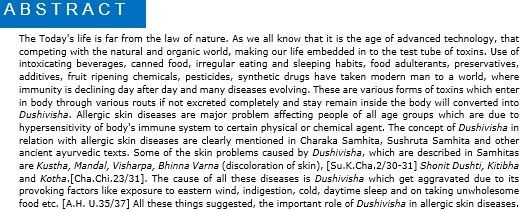Role of Dushivisha w.s.r. to Allergic Skin Diseases
DOI:
https://doi.org/10.21760/jaims.8.10.17Keywords:
Dushivisha, Allergic Skin Diseases, Avyadhisahtwa, Ojovyapad, KothaAbstract
The Today's life is far from the law of nature. As we all know that it is the age of advanced technology, that competing with the natural and organic world, making our life embedded in to the test tube of toxins. Use of intoxicating beverages, canned food, irregular eating and sleeping habits, food adulterants, preservatives, additives, fruit ripening chemicals, pesticides, synthetic drugs have taken modern man to a world, where immunity is declining day after day and many diseases evolving. These are various forms of toxins which enter in body through various routs if not excreted completely and stay remain inside the body will converted into Dushivisha. Allergic skin diseases are major problem affecting people of all age groups which are due to hypersensitivity of body's immune system to certain physical or chemical agent. The concept of Dushivisha in relation with allergic skin diseases are clearly mentioned in Charaka Samhita, Sushruta Samhita and other ancient ayurvedic texts. Some of the skin problems caused by Dushivisha, which are described in Samhitas are Kustha, Mandal, Visharpa, Bhinna Varna (discoloration of skin), [Su.K.Cha.2/30-31] Shonit Dushti, Kitibha and Kotha.[Cha.Chi.23/31]. The cause of all these diseases is Dushivisha which get aggravated due to its provoking factors like exposure to eastern wind, indigestion, cold, daytime sleep and on taking unwholesome food etc. [A.H. U.35/37] All these things suggested, the important role of Dushivisha in allergic skin diseases.
Downloads
References
Caraka Samhitā, Äyurvedadīpikā Commentary by Cakrapāëi, Edited by Vaidya Yādavajétrikamajé Ācārya. Varanasi: Chaukhambā Surabhāratī Prakāśana; 2011. Reprint Edition. p. 512.
Vāgbhata, Aṣṭāṅgahṛdaya Sarvāṅgasundarā Commentary by Aruṇadatta & Āyurvedarasāyana Commentary by Hemādri. Edited by Pt. Harisadāçivaçāstré Parāòakara. 1982. Reprint Edition. p. 155.
Charaka Samhita of Agnivesha elaborated by Charak and Drudhabala with the AyurvedaDipika commentary by Chakrapanidatta.
Susrhuta Samhita of Sushruta with Nibandhasangraha commentary of Sri Dalhanacharya and Nyayachandrika of Sri Gayadascharya on Nidansthana.
Astanga Hridaya of Vagbhata with the commentaries Sarvangasudara of Arunadatta & Ayurvedarasayan of Hemadri.
Harrison's Principles of Internal Medicine. 17th ed.
Sembulingam K, Sembulingam P. Essentials of Medical Physiology. 2nd ed.















